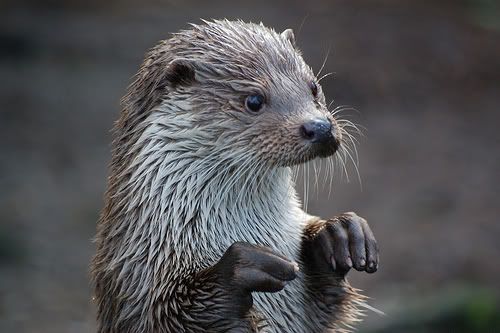Otters on the Chippewa River Trail Traditional Cache
Otters on the Chippewa River Trail
-
Difficulty:
-

-
Terrain:
-

Size:  (regular)
(regular)
Please note Use of geocaching.com services is subject to the terms and conditions
in our disclaimer.
Just north of the Chippewa River Trail, you will find a footpath
along the east side of the creek. The creek is Fall Creek, and is a
trout stream. It appears to be habitat that an otter would like,
though I did not see any otter tracks here. However, the DNR
reports that there are otter living in this area.
The otter has a long, tapered, muscular body, often seen gliding
just below the water’s surface. It is the largest member of
the weasel family, known for its broad head and small facial
features, except for a rather large nose pad.
Otters can be identified by their webbed feet, 2-4 inch whiskers
and a light tan cheek, chin, throat, and belly patch and thick
muscular tail. Otters measure about 3-4 feet long with a 12-18 inch
tail. You’ll find otters mostly in the northern half of
Wisconsin.
Otters eat fish such as suckers, minnows, sunfish, bass, and
minnows. Their second choice is crayfish, then frogs and
miscellaneous animals. They like to forage near shorelines,
overhanging banks, and areas where fish are found. They will also
eat birds and vegetation. Otters need about 3 square miles to find
all of this food.
Otters are known as playful animals. They like to wrestle, chase
other otters, and play capture and release with live prey. Each of
these "games" helps the otter become better coordinated and helps
them fit into the social structure of the group. In the winter,
you’ll find otters traveling overland by bounding 3-4 times,
pushing off with their hind feet, and then sliding 5-15 feet on the
snow.
Trapping is a Wisconsin tradition that began with the Native
Americans and continues today. Today, otters are one of
Wisconsin’s most intensively managed furbearers because of
their smaller population numbers than beaver and muskrat. The otter
trapping season is held during the middle of winter to ensure that
only prime furs are harvested. Because they live in the same
habitat as the beaver and muskrat, there has been concern that too
many otters may be taken accidentally in traps set for these other
wetland mammals.
According to the DNR, there are about 13,000 otters in Wisconsin.
Last year, 1322 were trapped, including several in Dunn
County.
The DNR uses aerial surviellance to track Otter numbers, which they
do in February every year. The aerial survey involves recording the
presence or absence of otter tracks at stream and river crossings
along 30-mile lines.

This is one of a series of caches along the Chippewa River Trail.
The route traces quiet countryside and broad meanders of the
Chippewa River. For the most part, it follows the rail bed of the
Milwaukee Road railway, built in 1882, which connected Eau Claire
to Red Wing, Minnesota. The railway was abandoned in 1980.
A trail pass is required to bike on the trail. Passes are available
at 44.47.165; 91.31.935, which is the Short Street range station.
Passes cost $15 for an annual pass, or $4 for a daily pass.
Additional Hints
(Decrypt)
AR pbeare.